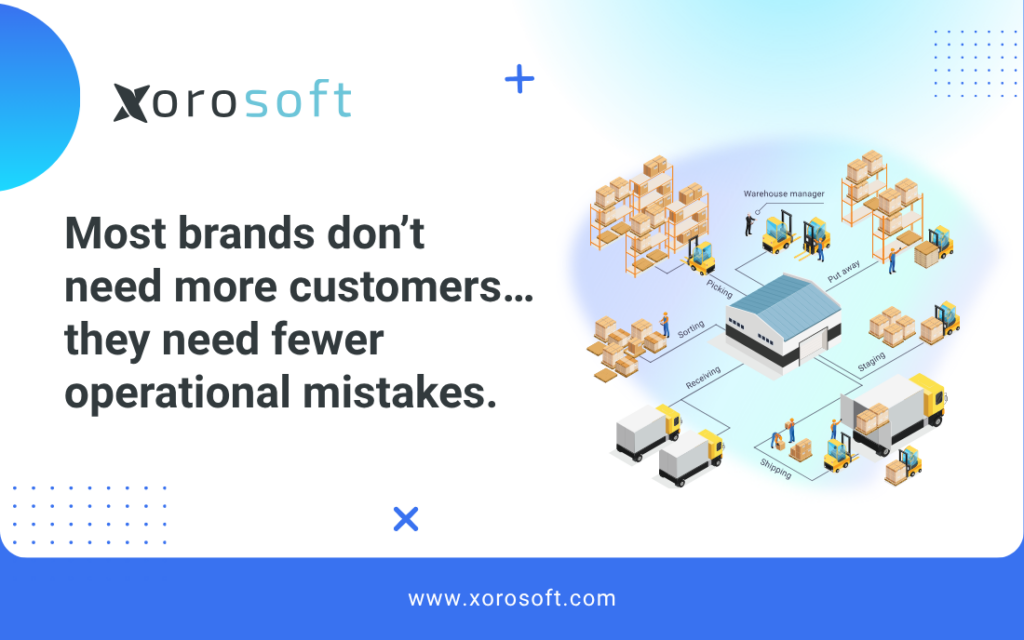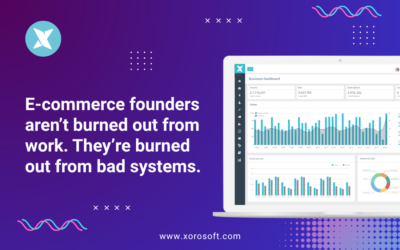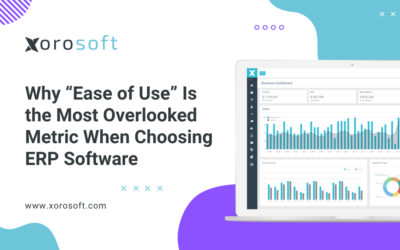
Why Fast-Growing Brands Need Operational Efficiency Software
Most DTC and omnichannel leaders eventually discover that growth doesn’t fail because demand slows but because they lack the right operational efficiency software and unified systems. As order volume increases, mistakes multiply, and teams become stuck in a cycle of rework and recovery. Although it feels counterintuitive, adding more customers usually magnifies existing inefficiencies instead of creating scalable growth.
Because of this, many operators share the same desire: to spend nearly all their time advancing the brand instead of solving preventable issues. As operations expand and complexity rises, achieving this becomes nearly impossible without a consolidated environment that reduces steps, eliminates errors, and improves visibility across every location, workflow, and team.
This guide breaks down the core frictions, the outcome metrics that matter, a practical step-by-step playbook, an example of a brand that regained control, and a simple day-by-day plan to help you create operational clarity quickly.
Key Insights to Guide Your Operational Strategy
Although every business faces unique challenges, most fast-scaling brands share similar symptoms. To help you evaluate your structure, here are the key takeaways of this guide:
-
Primary keyword: operational efficiency software
-
Core desire: spend more time growing the brand, not fixing operational failures
-
Common frictions: disconnected apps, manual reconciliation, reactive purchasing, tribal workflows, and late reporting
-
Outcome metrics: pick accuracy, order cycle time, inventory accuracy, stockout rate, and cash conversion
-
Playbook: six concrete steps to reduce mistakes and increase predictability
-
Included: case study, day-by-day plan, and operator-focused FAQs
The Hidden Causes Behind Operational Slowdowns
Although growth looks strong on the surface, daily operations often reveal a different reality. Many teams rely on fragmented systems—Shopify, Amazon, spreadsheets, shipping software, accounting tools, and manual processes. As a result, even simple workflows require extra steps, extra verification, and extra time.
Disconnected tools create multiple versions of the truth
When different parts of the business rely on different systems, discrepancies appear quickly. One dashboard may show 250 units on hand, another shows 102, and yet another reflects negative numbers. Because numbers don’t match, teams must stop what they’re doing to reconcile data that should have been in sync from the start.
Manual workarounds create unnecessary errors
Although early-stage brands can get by with spreadsheets and manual adjustments, those processes become liabilities as order volume grows. Copy/pasting SKUs, adjusting inventory by hand, or entering PO details manually is not a scalable strategy. However, these steps still exist in many workflows, quietly creating errors that compound over time.
Tribal knowledge slows decision-making
When crucial workflows exist only inside a few people’s heads, operations become fragile. As the team grows, new hires spend weeks trying to understand undocumented “real processes,” slowing everyone down and creating dependency on specific individuals rather than on a standardized system.
Reactive inventory management causes preventable costs
If your system can’t surface low stock alerts, forecast demand, or calculate landed costs accurately, inventory decisions become reactive. This leads to stockouts, overstocks, emergency shipments, and strained supplier relationships. However, these costs can be avoided with more complete visibility.
Delayed reporting hides emerging issues
Because many reports are manually built, they often arrive too late to influence decisions. While a brand may generate a weekly report showing rising returns or slow-moving stock, the opportunity to act has already passed.
These frictions create a cycle where growth amplifies problems instead of value. Fortunately, modern operational efficiency software solves these issues by consolidating inventory, warehouse operations, purchasing, manufacturing, accounting, and reporting into one real-time environment.
The Metrics That Reveal True Operational Performance
Operational excellence isn’t abstract—it’s measurable. When operators track the right metrics consistently, they gain a clear understanding of whether their systems are supporting or restricting growth.
Pick accuracy: the foundation of great customer experiences
Pick accuracy measures how reliably your warehouse team ships the right items. When accuracy falls, customers become frustrated, support tickets increase, and repeat purchase behavior declines. Because barcode-driven systems dramatically improve accuracy, operational efficiency software directly impacts this KPI.
Order cycle time: improving the speed from order to shipment
Order cycle time reflects how quickly your team processes incoming orders. When cycle times decrease, customer satisfaction rises and backlog decreases. As integrated systems eliminate manual steps, fulfillment becomes faster and more predictable.
Inventory accuracy: the most important metric for operators
Inventory accuracy affects every area of operations. Incorrect counts cause overselling, stockouts, poor purchasing decisions, and fulfillment delays. Because operational efficiency software updates inventory in real time, accuracy improves significantly.
Stockout rate: a direct measure of lost revenue
Stockouts not only hurt sales—they damage trust. As brands grow, preventing stockouts becomes more important, especially when demand spikes. With better planning signals and automated replenishment, stockouts become less frequent and less severe.
Cash conversion cycle: the heartbeat of your business
The cash conversion cycle measures how quickly you turn inventory investment into cash. By improving purchasing efficiency, reducing manual tasks, and increasing visibility into demand and fulfillment, brands typically shorten this cycle, freeing up working capital for growth.
By tracking these metrics consistently, operators can confidently identify what’s working, what’s not, and where to focus next.
Operational Efficiency Software Playbook for Reducing Mistakes
Below are six practical steps to help your team reduce errors, improve visibility, and move from reactive to proactive operations. Each step includes a clear goal, a specific action, and a measurable outcome.
1. Centralize all inventory and order data into one real-time system
Goal: Establish one version of the truth.
Action: Connect sales channels, warehouses, and purchasing workflows into a single environment.
Metric: Inventory accuracy above 97%.
Because centralization eliminates conflicting numbers, teams operate with greater confidence and clarity.
2. Standardize fulfillment using barcode-driven workflows
Goal: Reduce pick, pack, and ship errors.
Action: Implement mobile or handheld barcode scanning in all warehouse workflows.
Metric: Pick accuracy above 99%.
As scanning replaces manual entry, fulfillment becomes both faster and more reliable.
3. Automate purchasing and replenishment
Goal: Prevent stockouts and over-ordering.
Action: Use automated PO suggestions, min/max levels, and demand forecasts.
Metric: Stockout rate under 2%.
Because automation surfaces issues early, you avoid late reactivity.
4. Integrate accounting and operational systems
Goal: Eliminate reconciliation delays.
Action: Sync inventory, COGS, landed costs, and invoices into the same system.
Metric: Month-end close time cut by 40–60%.
With operational and financial data unified, accuracy and speed improve simultaneously.
5. Use exception-based reporting to detect issues early
Goal: Intervene before mistakes escalate.
Action: Set alerts for negative stock levels, delayed POs, or stalled fulfillment batches.
Metric: Fewer customer support tickets originating from operational errors.
Because issues surface automatically, teams shift from reaction to prevention.
6. Build daily KPI dashboards
Goal: Improve decision-making speed.
Action: Create dashboards for sales, margins, stock health, and open orders.
Metric: Daily decision cycles instead of weekly.
As real-time dashboards replace static reports, leaders gain immediate visibility into performance.
How Operational Efficiency Software Helped One Brand Regain Control
A growing DTC home goods brand generating around $12M annually struggled with operational chaos. Their inventory accuracy hovered near 80%, and constant overselling of their top SKUs harmed customer trust. Because their systems were split across spreadsheets, Shopify, a shipping app, and external accounting software, the team spent more time fixing errors than improving operations.
After adopting operational efficiency software from Xorosoft ERP—ranked #1 in Ease of Use on G2—their environment stabilized quickly.
-
Inventory accuracy rose to 98.4%
-
Pick errors dropped 68%
-
Cycle time improved from 2.3 days to 1.1 days
-
Month-end close fell from 12 days to 5 days
Because Xorosoft also integrates seamlessly with Shopify, the brand replaced multiple disconnected apps with one unified system.
A Five-Day Plan to Restore Operational Clarity
Although full transformation takes time, a structured reset can help your team regain control quickly.
Day 1 — Document your tech stack
List every tool used for order management, inventory, fulfillment, purchasing, accounting, and reporting.
Day 2 — Outline your true workflows
Record what actually happens, not what the SOP says. Because real processes differ from documented ones, capturing true behavior matters.
Day 3 — Identify major failure points
Note where delays, mismatches, or repetitive manual tasks occur. As patterns emerge, you’ll see where errors originate.
Day 4 — Evaluate where operational efficiency software reduces risk
Determine which systems cause friction and which workflows would benefit from consolidation.
Day 5 — Choose your operational KPIs
Select 4–6 KPIs—pick accuracy, cycle time, stockout rate, inventory accuracy, cash conversion—and commit to reviewing them daily.
Frequently Asked Questions from Operators
How do I know when we’ve outgrown spreadsheets or lightweight apps?
If reconciling numbers takes longer than analyzing them, or you’re selling across multiple channels or warehouses, you’ve outgrown your current tools.
How long does it take to deploy a modern platform?
Since Xorosoft ERP is cloud-native, deployment typically takes weeks rather than months.
Will my team adopt a new system?
Because operational efficiency software reduces steps instead of adding them, adoption is usually easy. Xorosoft’s ease-of-use ratings support this.
What if I already use a separate WMS or accounting tool?
Xorosoft supports integration and replacement, so you can unify systems at your own pace.
Strengthen Operational Control and Reduce Mistakes
If your team spends more time fixing issues than growing the brand, consolidation may be the next logical step. Xorosoft ERP provides an integrated system for inventory, WMS, purchasing, production, accounting, and reporting—giving operators the visibility and automation needed to scale confidently.
To explore how Xorosoft can simplify your operations, visit the Xorosoft website, check the G2 ranking, or review the Shopify App to see how seamlessly it connects to your existing channels.









